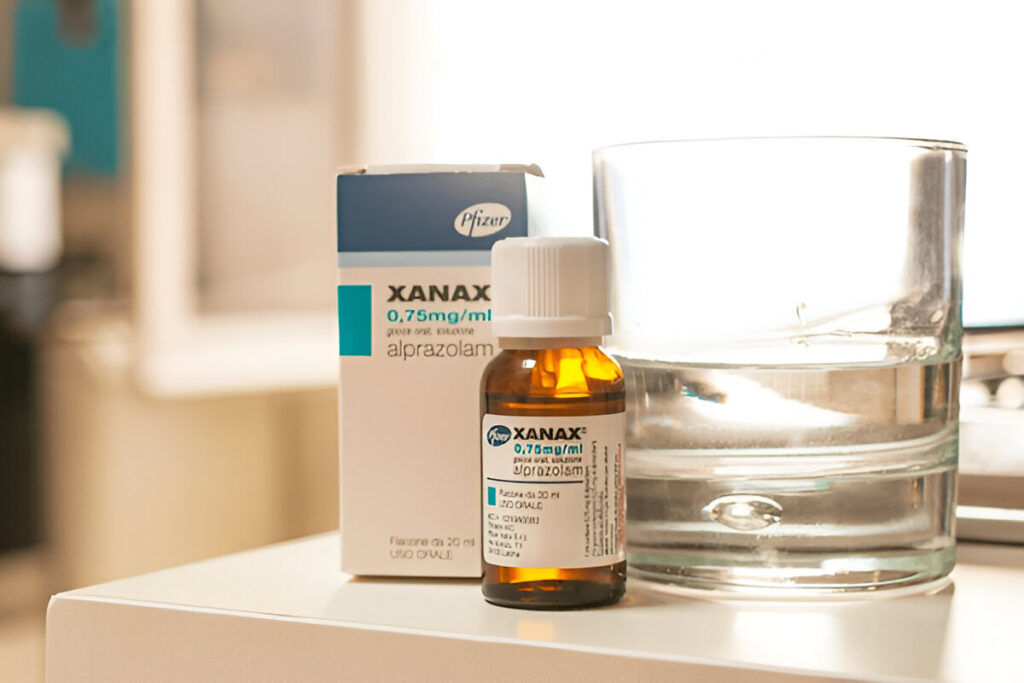- KNOWLEDGE BASE
- EATING DISORDERS
- General Topics
- No posts found for the specified taxonomy and term.
- General Topics
- EATING DISORDERS

SWISS MEDICAL EXPERTISE: ZURICH, MALLORCA, LONDON, MARBELLA


CONDITIONS WE TREAT
PROGRAMS
Intensive residential treatment program starting from 4 weeks. Location: Mallorca, Zurich, London.
Comprehensive second opinion assessments for both psychiatric and general health concerns. Location: Mallorca, Zurich, London
ADDITIONAL INFORMATION





10 Minutes
CONTENTS
Xanax, a widely prescribed benzodiazepine, is commonly used to manage many mental health conditions, such as anxiety. Known for its quick onset and efficacy, it works by calming the central nervous system. However, understanding how long Xanax remains in the body is fundamental, specifically for individuals undergoing treatment, wanting to take a drug test, or discontinuing its use.
The time it takes for Xanax to leave the system depends on several factors. While the medication’s effects may diminish relatively quickly, traces can stay in various body systems for days or even weeks. This article assesses the factors impacting Xanax elimination, detection periods, and what individuals should know about its metabolism.
Xanax, also known as alprazolam, has a complex metabolic process in the body before elimination. Its metabolism primarily occurs in the liver, where enzymes break down the medication into metabolites which are later excreted. This entire process includes the following stages:
After oral administration, Xanax gets into the blood through the gastrointestinal tract. Studies show that the medication has high bioavailability, which means a significant portion of the drug reaches the systemic circulation, resulting in quick effects. Within one to two hours, alprazolam reaches peak plasma concentration, making it an appropriate option for acute anxiety relief. [1]
The liver plays a fundamental role in Xanax metabolism. According to research, the cytochrome P450 enzyme system is responsible for breaking down the drug. The enzymes in this system break down alprazolam into inactive metabolites, including alpha-hydroxyalprazolam and 4-hydroxyalprazolam. These metabolites have low pharmacological activity compared to the main compound which means they contribute little to Xanax’s overall impact on the body. [2]
The half-life of Xanax, i.e., the time it takes for half the drug to leave the bloodstream, is around eleven to sixteen hours in healthy adults. However, the complete elimination of the drug may take several days, depending on individual metabolic rates and other factors.
Once metabolized, Xanax and its inactive metabolites are excreted through the kidneys. Around eighty percent of the drug is eliminated in the urine, while a comparatively smaller portion goes out through bile and feces. Proper kidney function is essential for efficient excretion, making renal health a factor in understanding how long alprazolam remains in the system.
The speed and efficiency of Xanax metabolism can vary significantly between individuals because of factors such as age, genetics, use of other medications, and gender. For example, substances that inhibit enzymes in the P450 enzyme system, such as certain antibiotics, can reportedly slow the metabolism of alprazolam, prolonging its impact and presence in the body. [3]
The duration of the period Xanax remains in the body varies among individuals because of various influencing factors. These factors impact the drug’s absorption, metabolism, and excretion, resulting in differences in elimination times.
Age significantly impacts how the body processes Xanax. Older individuals tend to metabolize and eliminate the drug more slowly in comparison to younger people. The delay is primarily because of age-related declines in liver and kidney function, which can decrease the efficiency of Xanax metabolism. As a result, older adults may experience the effects of the drug for a prolonged period and have detectable levels in their system for a longer time as well.
Factors such as body weight and fat percentage impact how long does Xanax stay in your urine or blood. Xanax is lipophilic, which means it binds to fat cells in the body. Individuals with higher body fat percentages may have the drug longer, leading to slower excretion. On the other hand, leaner individuals may process and excrete alprazolam more quickly.
The liver plays an important part in metabolizing and removing alprazolam. Individuals with issues in liver function, such as cirrhosis or hepatitis, usually metabolize the drug slowly. Decreased enzyme activity in the liver can also increase the drug’s half-life, resulting in a longer time for Xanax to be cleared from the system.
While Xanax primarily breaks down in the liver, its metabolites can be excreted through the kidneys. Problems in kidney function, therefore, can slow the excretion process, causing metabolites to accumulate in the body.
Chronic or long-term use of Xanax can make the drug accumulate in the body. Regular use also increases the drug’s concentration in fat cells, increasing the time of its presence in the system even after discontinuation. Infrequent or short-term users, on the other hand, tend to eliminate alprazolam more quickly.
The amount of Xanax taken directly impacts how long it stays in the system. Higher doses take more time to metabolize and excrete compared to lower doses. Similarly, extended-release formulations also remain active in the body longer than immediate-release versions, further increasing the elimination time.
Genetic variations in liver enzyme activity can influence how individuals metabolize alprazolam. Some individuals process the drug more slowly, resulting in increased elimination times. Conversely, some can metabolize Xanax rapidly, which clears the drug more quickly.
The use of other medications can either speed up or slow down alprazolam metabolism. Drugs that slow down the enzymes involved in Xanax metabolism, such as certain antifungal agents, antibiotics, or grapefruit juice, can prolong its presence in the body. On the other hand, medications that induce these liver enzymes can speed up the metabolism, reducing the drug’s duration in the system.
General health, including hydration levels and metabolism, also impacts how quickly Xanax is eliminated from the body. While poor general health, chronic illnesses, or dehydration can slow down its excretion, healthy lifestyle habits may aid in faster clearance of alprazolam.
Xanax can remain detectable in many parts of the body for different durations, depending on the testing method used. Each system processes the drug distinctively, which consequently affects detection timelines. The following is an overview of the detection of alprazolam in the most commonly used testing methods:
Blood tests can be an effective way to detect Xanax after acute consumption, as the drug is rapidly absorbed into the blood.
Urine tests are one of the most common methods for detecting Alprazolam due to their simplicity and long detection period.
Saliva tests provide a non-invasive method to detect Xanax but have a shorter detection window compared to other methods.
Hair tests provide the longest detection window for alprazolam, making them a valuable tool for identifying long-term use.
Detecting Xanax can be helpful in various contexts, and understanding when and why detection is necessary helps ensure safety, compliance, and effective treatment. The following are some of the situations where alprazolam detection is crucial:
Detecting Xanax is essential for healthcare providers to check its proper use and prevent complications.
Xanax detection is usually required in legal and professional settings to maintain safety and compliance.
Detecting Xanax is crucial in addiction treatment and recovery programs to ensure efficacy and progress.
In emergency and forensic scenarios, alprazolam detection can assist in potentially saving lives.
If prescribed Xanax, preparing for a drug test requires careful steps to avoid misunderstandings. Consider the following steps to ensure transparency while staying out of trouble:
The time it takes for Xanax to leave the body depends on various factors, including dosage, frequency of use, individual metabolism, and general health. While its effects may wear off within hours, traces of Xanax can remain detectable in different parts of the body for days or even weeks. Understanding its metabolism, detection windows, and the factors that influence elimination can be helpful for individuals in treatment who want to take drug testing. By knowing about Xanax’s pharmacology and following medical guidance, individuals can use alprazolam responsibly, reducing risks and ensuring a safer approach to managing anxiety or other mental health conditions.
There is no guaranteed way to quickly eliminate Xanax from the body, as its metabolism depends on liver enzymes and individual health factors. However, staying hydrated, consuming a balanced diet, and exercising can support natural detoxification processes. It is crucial to talk to a healthcare provider before attempting to change drug metabolism, as sudden changes or unsafe methods can cause complications.
Individuals with kidney issues may have Xanax metabolites in urine for a longer time due to decreased excretion efficiency. While the liver primarily metabolizes Xanax, its byproducts exit through the kidneys. This means impaired kidney function can also increase the detection window. In such cases, traces of Xanax can remain detectable for over a week.
Yes, children generally have faster metabolic rates than adults, which can result in quicker processing and excretion of medications like Xanax. However, Xanax is not typically prescribed for children as its effects on developing bodies are not well-studied. Always talk to a healthcare provider for appropriate treatments for anxiety or related conditions in children, and do not attempt to give them any medication without consultation.
Yes, even small doses of alprazolam can be detected in drug tests, particularly in methods like urine or hair analysis. Detection depends on factors such as the sensitivity of the test and the individual’s metabolism. It’s vital to disclose any prescribed use before testing to avoid misinterpretation of results.
COGNIFUL is a leading provider of luxury addiction and mental health treatment for affluent individuals and their families, offering a blend of innovative science and holistic methods with unparalleled individualised care.
We believe in the healing power of a community that brings together collective wisdom and individual insight from collective group sessions and activities. We offer a variety of activities and therapies, from group workshops to communal living experiences, every aspect of our program is designed to foster growth, understanding, and self-improvement.
more infoOur program is uniquely designed to meet your needs, with our team closely monitoring your progress. Our therapists are committed to addressing the underlying causes of your challenges, not just the surface symptoms. This deep, root-level therapy extends beyond your stay with us, ensuring enduring success and well-being.
more infoOur team of specialists integrates the most effective strategies from psychological care and holistic medicine, offering you personalized support. This approach includes a range of complementary therapies, all seamlessly coordinated to work together in a comprehensive, integrative manner for your benefit.
more infoThroughout your stay, our dedicated team will ensure a personalized and nurturing experience, providing continuous support and attention. We are committed to guiding you through every step of this transformative journey.
more infoNestled in a serene location close to the calming embrace of the beach, our luxury residence is designed with healing in mind, featuring private suites that offer an oasis of tranquility. Each suite is crafted to provide a personal sanctuary where individuals can reflect, rejuvenate, and recover in peace.
more infoComplex trauma frequently underlies both mental and physical distress. We offer a secure environment, incorporating integrated trauma treatment techniques to facilitate the healing process.
more info